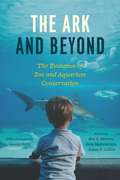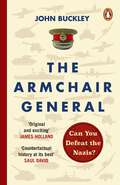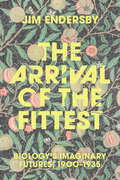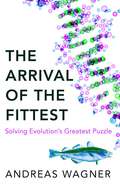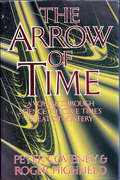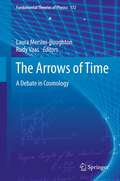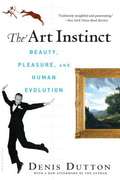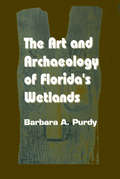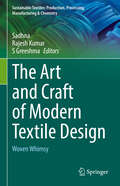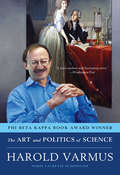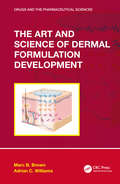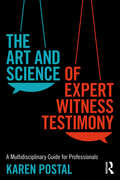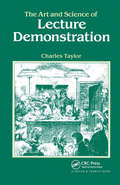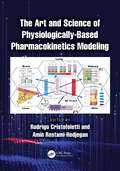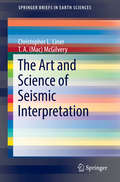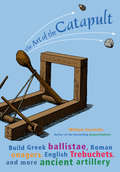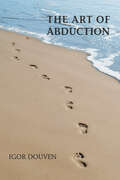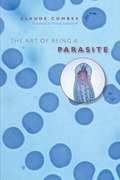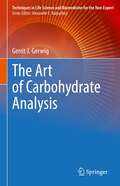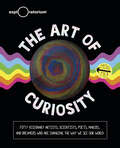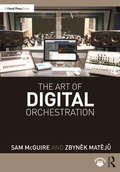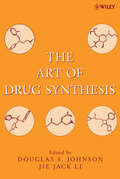- Table View
- List View
The Ark and Beyond: The Evolution of Zoo and Aquarium Conservation (Convening Science: Discovery At The Marine Biological Laboratory Ser.)
by Ben A. Minteer Jane Maienschein James P. CollinsScores of wild species and ecosystems around the world face a variety of human-caused threats, from habitat destruction and fragmentation to rapid climate change. But there is hope, and it, too, comes in a most human form: zoos and aquariums. Gathering a diverse, multi-institutional collection of leading zoo and aquarium scientists as well as historians, philosophers, biologists, and social scientists, The Ark and Beyond traces the history and underscores the present role of these organizations as essential conservation actors. It also offers a framework for their future course, reaffirming that if zoos and aquariums make biodiversity conservation a top priority, these institutions can play a vital role in tackling conservation challenges of global magnitude. While early menageries were anything but the centers of conservation that many zoos are today, a concern with wildlife preservation has been an integral component of the modern, professionally run zoo since the nineteenth century. From captive breeding initiatives to rewilding programs, zoos and aquariums have long been at the cutting edge of research and conservation science, sites of impressive new genetic and reproductive techniques. Today, their efforts reach even further beyond recreation, with educational programs, community-based conservation initiatives, and international, collaborative programs designed to combat species extinction and protect habitats at a range of scales. Addressing related topics as diverse as zoo animal welfare, species reintroductions, amphibian extinctions, and whether zoos can truly be “wild,” this book explores the whole range of research and conservation practices that spring from zoos and aquariums while emphasizing the historical, scientific, and ethical traditions that shape these efforts. Also featuring an inspiring foreword by the late George Rabb, president emeritus of the Chicago Zoological Society / Brookfield Zoo, The Ark and Beyond illuminates these institutions’ growing significance to the preservation of global biodiversity in this century.
The Armchair General: Can You Defeat the Nazis? (The Armchair General #1)
by John BuckleyA ground-breaking approach to history where YOU choose the fate of WWII - perfect for readers of Bletchley Park Brainteasers and The GCHQ Puzzle Book.''An original and exciting approach . . . Buckley is one of our very finest historians.' JAMES HOLLAND________________________TAKE THE HOTSEATAssume the role of real Generals, Leaders, Soldiers and Intelligence Officers in the Allied Forces during WWII, including Winston Churchill and President Eisenhower.EXAMINE THE INTELLIGENCEExplore eight key moments of the war with real contemporaneous intelligence: Britain's Darkest Hour, 1940; The War in North Africa; Stalin's War on the Eastern Front; The Pacific Battle of Midway; The Dresden Bomber Offensive; Casablanca; Arnhem and Operation Market Garden; The Bomb and Hiroshima.CONSIDER THE SCENARIO & MAKE YOUR DECISIONFrom battlefields to war cabinets, each tactical and strategic decision you make leads to a different outcome.Will you follow the path of the past - or shape a new history?________________________'Wonderfully original . . . putting readers at the heart of the decision-making process and allowing them, literally, to change the course of history. This is counterfactual history at its best.' SAUL DAVID'A reminder that history is a never ending now, a relentless and endless present that comes without the luxury of hindsight.' AL MURRAY'An original and exciting approach . . . Buckley is one of our very finest historians. The Armchair General adds enormously to our understanding of the conflicts.' JAMES HOLLAND'A unique, enjoyable approach to evaluating military decision-making.' HISTORY OF WAR
The Arrival of the Fittest: Biology's Imaginary Futures, 1900–1935
by Jim EndersbyIn the early twentieth century, varied audiences took biology out of the hands of specialists and transformed it into mass culture, transforming our understanding of heredity in the process. In the early twentieth century communities made creative use of the new theories of heredity in circulation at the time, including the now largely forgotten mutation theory of Hugo de Vries. Science fiction writers, socialists, feminists, and utopians are among those who seized on the amazing possibilities of rapid and potentially controllable evolution. De Vries’s highly respected scientific theory only briefly captured the attention of the scientific community, but its many fans appropriated it for their own wildly imaginative ends. Writers from H.G. Wells and Edith Wharton to Charlotte Perkins Gilman, J.B.S. Haldane, and Aldous Huxley created a new kind of imaginary future, which Jim Endersby calls the biotopia. It took the ambiguous possibilities of biology—utopian and dystopian—and reimagined them in ways that still influence the public’s understanding of the life sciences. The Arrival of the Fittest recovers the fascinating, long-forgotten origins of ideas that have informed works of fiction from Brave New World to the X-Men movies, all while reflecting on the lessons—positive and negative—that this period might offer us.
The Arrival of the Fittest: Solving Evolution's Greatest Puzzle
by Andreas WagnerWe all know about natural selection and the so-called survival of the fittest, which governs how evolution preserves useful adaptations in each subsequent generation of a species. Unfortunately, random change alone could not have produced life as we know it - the maths don't add up, according to cutting-edge research by Andreas Wagner in the revolutionary field of computational biology.In the last decade, Wagner has detected the biological networks guiding the creation of innovation. His investigations of the genes of everything from bacteria to humans is rewriting our understanding of how exactly evolution works and providing insights into the origins of creativity, with lessons that can be applied far beyond genomes.In The Arrival of the Fittest, Wagner delivers a breathtaking new look at our origins, from the genes up.
The Arrow Of Time
by Roger Highfield Dr Peter CoveneyIn our century, the subject of time has become an area of serious inquiry for science. Theories that contain time as a simple quantity form the basis of our understanding of many scientific disciplines, yet the debate rages on: why does there seem to be a direction to time, an arrow of time pointing from past to future?In this authoritative and accessible Sunday Times bestseller, physical chemist Dr Peter Coveney and award-winning science journalist Dr Roger Highfield demonstrate that the common sense view of time agrees with the most advanced scientific theory. Time does in fact move like an arrow, shooting forward into what is genuinely unknown, leaving the past immutably behind. The authors make their case by exploring three centuries of science, offering bold reinterpretations of Newton’s mechanics, Einstein’s special and general theories of relativity, quantum mechanics, and advancing the insights of chaos theory. In their voyage through science the authors link apparently irreconcilable subjects, from Einstein’s obsession with causality to chaos theory, from Marvell’s winged chariot to that Monday morning feeling.Finally, drawing together the various interpretations of time, they describe a novel way to give it a sense of direction. And they call for a new fundamental theory to take account of the Arrow of Time.Foreword by Ilya Prigogine, Nobel laureate.
The Arrows of Time
by Laura Mersini-Houghton Rudy VaasThe concept of time has fascinated humanity throughout recorded history, and it remains one of the biggest mysteries in science and philosophy. Time is clearly one of the fundamental building blocks of the universe and thus a deeper understanding of nature at a fundamental level also demands a comprehension of time. Furthermore, the origins of the universe are closely intertwined with the puzzle of time: Did time emerge at the Big Bang? Why does the arrow of time 'conspire' with the order of the initial state of the universe? This book addresses many of the most important questions about time: What is time, and is it fundamental or emergent? Why is there such an arrow of time, closely related to the initial state of the universe, and why do the cosmic, thermodynamic and other arrows agree? These issues are discussed here by leading experts, and each offers a new perspective on the debate. Their contributions delve into the most difficult research topic in physics, also describing the latest cutting edge research on the subject. The book also offers readers a comparison between the different outlooks of philosophy, physics and cosmology on the puzzle of time. This volume is intended to be useful for research purposes, but most chapters are also accessible to a more general audience of scientifically educated readers looking for deeper insights.
The Art Instinct: Beauty, Pleasure, & Human Evolution
by Denis DuttonThe Art Instinct combines two of the most fascinating and contentious disciplines, art and evolutionary science, in a provocative new work that will revolutionize the way art itself is perceived. Aesthetic taste, argues Denis Dutton, is an evolutionary trait, and is shaped by natural selection. It's not, as almost all contemporary art criticism and academic theory would have it, "socially constructed.
The Art and Archaeology of Florida's Wetlands
by BarbaraA. PurdyWaterlogged archaeological sites in Florida contain tools, art objects, dietary items, human skeletal remains, and glimpses of past environments that do not survive the ravages of time at typical terrestrial sites. Unfortunately, archaeological wet sites are invisible since their preservation depends upon their entombment in oxygen-free, organic deposits. As a result, they are often destroyed accidentally during draining, dredging, and development projects. These sites and the objects they contain are an important part of Florida's heritage. They provide an opportunity to learn how the state's earliest residents used available resources to make their lives more comfortable and how they expressed themselves artistically. Without the wood carvings from water-saturated sites, it would be easy to think of early Floridians as culturally impoverished because Florida does not have stone suitable for creating sculptures. This book compiles in one volume detailed accounts of such famous sites as Key Marco, Little Salt Spring, Windover, Ft. Center, and others. The book discusses wet site environments and explains the kinds of physical, chemical, and structural components required to ensure that the proper conditions for site formation are present and prevail through time. The book also talks about how to preserve artifacts that have been entombed in anaerobic deposits and the importance of classes of objects, such as wooden carvings, dietary items, human skeletal remains, to our better understanding of past cultures. Until now this information has been scattered in obscure documents and articles, thus diminishing its importance. Our ancestors may not have been Indians, but they contributed to the state's heritage for more than 10,000 years. Once disturbed by ambitious dredging and draining projects, their story is gone forever; it cannot be transplanted to another location.
The Art and Craft of Modern Textile Design: Woven Whimsy (Sustainable Textiles: Production, Processing, Manufacturing & Chemistry)
by Rajesh Kumar Sadhna S. GreeshmaThis contributed volume explores the craft and science of modern textile design. It offers a carefully curated collection of essays, insights, and case studies. The chapters presented here exist where craftsmanship converges with cutting-edge technology and traditional techniques, dance with avant-garde experimentation, and illustrate how fabric can unlock limitless possibilities of artistic expression. From the historical roots that anchor contemporary practices to the forefront of technological advancements shaping the industry, this book offers a panoramic view of the field. The chapters celebrate the artistry behind the loom and the visionary designers who push the boundaries of conventional thinking, transforming threads into transcendent works of art. As the title suggests, this volume is not just about technique; it explores the imaginative spirit that breathes life into fibers. The book invites readers to witness the synergy between tradition and innovation, uncover the narrative threads woven into every fabric, and appreciate the extraordinary craftsmanship that elevates textiles beyond mere utility. This edited volume is designed to appeal to a diverse audience – from students and scholars to industry professionals and anyone with an appreciation for the intersection of art and function. The book aims to provide readers with a thorough understanding of the various facets of contemporary textile design, from historical influences to emerging trends.
The Art and Politics of Science
by Harold VarmusA Nobel Prize-winning cancer biologist, leader of major scientific institutions, and scientific adviser to President Obama reflects on his remarkable career. A PhD candidate in English literature at Harvard University, Harold Varmus discovered he was drawn instead to medicine and eventually found himself at the forefront of cancer research at the University of California, San Francisco. In this "timely memoir of a remarkable career" (American Scientist), Varmus considers a life's work that thus far includes not only the groundbreaking research that won him a Nobel Prize but also six years as the director of the National Institutes of Health; his current position as the president of the Memorial Sloan-Kettering Cancer Center; and his important, continuing work as scientific adviser to President Obama. From this truly unique perspective, Varmus shares his experiences from the trenches of politicized battlegrounds ranging from budget fights to stem cell research, global health to science publishing.
The Art and Science of Dermal Formulation Development (Drugs and the Pharmaceutical Sciences)
by Marc B. Brown Adrian C. WilliamsThe Art and Science of Dermal Formulation Development is a comprehensive guide to the theory and practice of transdermal and topical formulation development, covering preclinical studies, evaluation, and regulatory approval. It enables the reader to understand the opportunities and challenges in developing products and how risks can be mitigated. Over the last 25 years, expertise in this area has declined whilst drug delivery systems for other administration routes have developed significantly. The advantages offered by transdermal and topical drug delivery remain compelling for sectors including the pharmaceutical industry, personal care, and cosmetics. This text addresses the dearth of expertise and discusses how skin can be a route of delivery and the processes in formulation development, but how such an application is very different to that used for oral, IV, and other administration routes.
The Art and Science of Expert Witness Testimony: A Multidisciplinary Guide for Professionals
by Karen PostalFeaturing in-depth interviews of attorneys, judges, and seasoned forensic experts from multiple disciplines including psychology, medicine, economics, history, and neuropsychology, The Art and Science of Expert Witness Testimony highlights and offers bridges for the areas where the needs and expectations of the courtroom collide with experts’ communication habits developed over years of academic and professional training. Rather than seeing testimony as a one-way download from expert to jurors, The Art and Science of Expert Witness Testimony focuses on the direct, dynamic, unique communication relationship that develops as each juror’s lived experience interacts with the words of experts on the stand. This book expands the academic tradition of "methods-centered credibility" to also include "person-centered credibility," where warmth, confidence, and relentless attention to detail build trust with jurors. Seasoned forensic experts share what they actually say on the stand: their best strategies and techniques for disrupting traditional academic communication and creating access to science and professional opinions with vivid, clear language and strong visuals. The difficult but necessary emotional work of the courtroom is addressed with specific techniques to regulate emotions in order to maintain person-centered credibility and keep the needs of jurors front and center through cross-examination. This innovative compilation of research is essential reading for professionals and practitioners, such as physicians, engineers, accountants, and scientists, that may find themselves experts in a courtroom. The Art and Science of Expert Witness Testimony provides a unique experience for readers, akin to being personally mentored by over eighty-five attorneys, judges, and seasoned experts as they share their observations, insights, and strategies—not to "win" as a defense, prosecution, or plaintiff expert, but to be productive in helping jurors and other triers of fact do their difficult intellectual job in deciding a case.
The Art and Science of Lecture Demonstration
by C.A TaylorAs a means of conveying the excitement of science from one generation to the next, the lecture demonstration is one of the most powerful tools at the disposal of the modern science teacher. The interest of the young aspiring scientist is aroused not by dull textbook recitation, but by the enthusiastic lecturer with a range of demonstrations that il
The Art and Science of Physiologically-Based Pharmacokinetics Modeling
by Rodrigo CristofolettiThis state-of-the-art text describes the science behind the system and drug-dependent components of PBPK models, its applications in translational and regulatory science, e.g., guiding drug discovery and development, and supporting precision medicine initiatives. To incorporate state-of-the-art knowledge, each chapter is written by leaders in the field and illustrated by clear case studies. Connecting basic and applied science, this book explores the potential of PBPK modeling for improving therapeutics and is designed for a wide audience encompassing graduate students as well as biopharmaceutics scientists and clinical pharmacologists.Features:1. Provides a basic understanding of the physiologically-based pharmacokinetic modeling and its applications2. Assists the reader in understanding product performance to allow for rapid product development and establish bioequivalence3. Well-constructed content and added value of real examples4. Illustrates how using available resources via modeling and simulation leads to a reduction in the costs related to drug development, which directly affects the costs to patients
The Art and Science of Seismic Interpretation (SpringerBriefs in Earth Sciences)
by Christopher L. Liner T. A. McGilveryThis book demystifies that art and science of seismic interpretation for those with and without formal geophysical training. From geologists to managers and investors, The Art and Science of Seismic Interpretation is a guide to what seismic data is, how it is interpreted, and what it can deliver.
The Art and Science of Seismic Interpretation (SpringerBriefs in Earth Sciences)
by Christopher L. Liner T. A. McGilveryThis book demystifies that art and science of seismic interpretation for those with and without formal geophysical training. From geologists to managers and investors, The Art and Science of Seismic Interpretation is a guide to what seismic data is, how it is interpreted, and what it can deliver.
The Art of Catapult: Build Greek Ballistae, Roman Onagers, English Trebuchets, and More Ancient Artillery
by William GurstelleWhether playing at defending their own castle or simply chucking pumpkins over a fence, wannabe marauders and tinkerers will become fast acquainted with Ludgar, the War Wolf, Ill Neighbor, Cabulus, and the Wild Donkey--ancient artillery devices known commonly as catapults. Building these simple yet sophisticated machines introduces fundamentals of math and physics using levers, force, torsion, tension, and traction. Instructions and diagrams illustrate how to build seven authentic working model catapults, including an early Greek ballista, a Roman onager, and the apex of catapult technology, the English trebuchet. Additional projects include learning how to lash and make rope and how to construct and use a hand sling and a staff sling. The colorful history of siege warfare is explored through the stories of Alexander the Great and his battle of Tyre; Saladin, Richard the Lionheart, and the Third Crusade; pirate-turned-soldier John Crabbe and his ship-mounted catapults; and Edward I of England and his battle against the Scots at Stirling Castle.
The Art of Abduction
by Igor DouvenA novel defense of abduction, one of the main forms of nondeductive reasoning.With this book, Igor Douven offers the first comprehensive defense of abduction, a form of nondeductive reasoning. Abductive reasoning, which is guided by explanatory considerations, has been under normative pressure since the advent of Bayesian approaches to rationality. Douven argues that, although it deviates from Bayesian tenets, abduction is nonetheless rational. Drawing on scientific results, in particular those from reasoning research, and using computer simulations, Douven addresses the main critiques of abduction. He shows that versions of abduction can perform better than the currently popular Bayesian approaches—and can even do the sort of heavy lifting that philosophers have hoped it would do. Douven examines abduction in detail, comparing it to other modes of inference, explaining its historical roots, discussing various definitions of abduction given in the philosophical literature, and addressing the problem of underdetermination. He looks at reasoning research that investigates how judgments of explanation quality affect people&’s beliefs and especially their changes of belief. He considers the two main objections to abduction, the dynamic Dutch book argument, and the inaccuracy-minimization argument, and then gives abduction a positive grounding, using agent-based models to show the superiority of abduction in some contexts. Finally, he puts abduction to work in a well-known underdetermination argument, the argument for skepticism regarding the external world.
The Art of Astrophotography
by Ian MorisonIn The Art of Astrophotography, astronomer and Astronomy Now columnist Ian Morison provides the essential foundations of how to produce beautiful astronomical images. Every type of astroimaging is covered, from images of the Moon and planets, to the constellations, star clusters and nebulae within our Milky Way Galaxy and the faint light of distant galaxies. He achieves this through a series of worked examples and short project walk-throughs, detailing the equipment needed - starting with just a DSLR (digital single lens reflex) camera and tripod, and increasing in complexity as the book progresses - followed by the way to best capture the images and then how, step by step, these may be processed and enhanced to provide results that can rival those seen in astronomical magazines and books. Whether you are just getting into astrophotography or are already deeply involved, Morison's advice will help you capture and create enticing astronomical images.
The Art of Being a Parasite
by Claude CombesParasites are a masterful work of evolutionary art. The tiny mite Histiostoma laboratorium, a parasite of Drosophila, launches itself, in an incredible display of evolutionary engineering, like a surface-to-air missile at a fruit fly far above its head. Gravid mussels such as Lampsilis ventricosa undulate excitedly as they release their parasitic larval offspring, conning greedy predators in search of a tasty meal into hosting the parasite.The Art of Being a Parasite is an extensive collection of these and other wonderful and weird stories that illuminate the ecology and evolution of interactions between species. Claude Combes illustrates what it means to be a parasite by considering every stage of its interactions, from invading to reproducing and leaving the host. An accessible and engaging follow-up to Combes's Parasitism, this book will be of interest to both scholars and nonspecialists in the fields of biodiversity, natural history, ecology, public health, and evolution.
The Art of Being a Scientist
by Roel Snieder Ken LarnerThis is a hands-on guide for graduate students and young researchers wishing to perfect the practical skills needed for a successful research career. By teaching junior scientists to develop effective research habits, the book helps to make the experience of graduate study a more efficient and rewarding one. This book is an outgrowth of the notes for the graduate course, "The Art of Science," taught by the authors at Colorado School of Mines and highly rated and appreciated by students over the years. A sample curriculum, which parallels the curriculum followed in the authors' course, is available in the book as Appendix B, and as an online resource. This sample is offered as a possible starting point for instructors in graduate schools wanting to teach a similar course at their university. Topics covered in the book include: choosing a research topic, department, and advisor; making workplans; the ethics of research; using scientific literature; perfecting oral and written communication; publishing papers; writing proposals; managing time effectively; and planning a scientific career and applying for jobs in research and industry. The wealth of advice is invaluable to students, junior researchers and mentors in all fields of science, engineering, and the humanities.
The Art of Carbohydrate Analysis (Techniques in Life Science and Biomedicine for the Non-Expert)
by Gerrit J. GerwigThe growing importance of glycobiology and carbohydrate chemistry in modern biotechnology and the pharmaceutical industry makes accurate carbohydrate analysis indispensable. This book provides the principles and protocols of various fundamental carbohydrate analysis methods. Choice of method is entirely dependent upon the type of material being investigated (biological samples, food products, etc.), and the level of structural detail required, i.e. sugar content, compositional analysis, linkages between the sugar components, or the total chemical structure of a given molecule. Full structural characterization of carbohydrate chains requires significant time, resources, and skill in several methods of analysis; no single technique can address all glycan analysis needs.This book summarizes several existing analytical techniques (both chemical and physical) in an introductory volume designed for the non-expert researcher or novice scientist. While background in carbohydrate chemistry is assumed, all information necessary to understanding the described techniques is addressed in the text.
The Art of Curiosity: Fifty Visionary Artists, Scientists, Poets, Makers, and Dreamers Who Are Changing the Way We See Our World
by ExploratoriumFifty of the world’s most creative people share their stories and inspirations in this volume created by the Exploratorium science museum.What do music visionary Brian Eno, kinetic sculptor Theo Jansen, science writer Mary Roach, Mythbuster Adam Savage, and Pulitzer-winning journalist Thomas Friedman have in common? They are all game-changers: scientists, artists, entertainers, and activists who revolutionized their fields with bold new perspectives and approaches—and they all had transformative, course-setting experiences at the Exploratorium science museum, the San Francisco landmark visited by a million people a year in person and by millions more online.Join them and forty-five more brilliant thinkers and doers in a wonderfully playful, insightful, and sometimes incredibly moving journey to see how you, too, can harness your powers of observation, inquiry, and engagement to be the change you want to see in the world—regardless of who you are or what you do. Interviewees and subjects include:Oscar-Winning Sound Designer Walter Murch on observationLaurie Anderson on art as a way of knowingMemory Expert Elizabeth Loftus on how we learnOliver Sacks on perceptionMary Roach on how she learned to ask the right questionsAdam Savage on the fun of finding things outMickey Hart on the art of playing to learn, and learning to playCalifornia Governor Gavin Newsom on the importance of scienceCommunity activist Randy Carter on finding joy in the worst of places . . . and dozens more interviews, insights, and activities suggested by artists, scientists, poets, and politicians, in a book that can help you become more creative—and maybe just change the world.
The Art of Digital Orchestration
by Sam McGuire Zbyněk MatějůThe Art of Digital Orchestration explores how to replicate traditional orchestration techniques using computer technology, with a focus on respecting the music and understanding when using real performers is still the best choice. Using real-world examples including industry-leading software and actual sounds and scores from films, VR/AR, and games, this book takes readers through the entire orchestration process, from composition to instruments, performance tools, MIDI, mixing, and arranging. It sheds light on the technology and musical instrument foundation required to create realistic orchestrations, drawing on decades of experience working with virtual instruments and MIDI. Bringing together the old and new, The Art of Digital Orchestration is an excellent resource for anyone using software to write or compose music. The book includes access to online videos featuring orchestration techniques, MIDI features, and instrument demonstrations.
The Art of Drug Synthesis
by Jie Jack Li Douglas S. JohnsonThe Art of Drug Synthesis illustrates how chemistry, biology, pharmacokinetics, and a host of other disciplines come together to produce successful medicines. The authors have compiled a collection of 21 representative categories of drugs, from which they have selected as examples many of the best-selling drugs on the market today. An introduction to each drug is provided, as well as background to the biology, pharmacology, pharmacokinetics, and drug metabolism, followed by a detailed account of the drug synthesis.Edited by prominent scientists working in drug discovery for PfizerMeets the needs of a growing community of researchers in pharmaceutical R&DProvides a useful guide for practicing pharmaceutical scientists as well as a text for medicinal chemistry studentsAn excellent follow-up to the very successful first book by these editors, Contemporary Drug Synthesis, but with all new therapeutic categories and drugs discussed.
